Social commerce is changing the way we shop online. From the live-streaming trends in China to WhatsApp storefronts in India and influencer-driven sales in the U.S., let’s explore how these major players are revolutionizing digital retail.
Table of Contents
The New Age of Interactive Shopping
Shopping online used to be a breeze. You clicked, made your purchase, and then just waited for it to arrive. But nowadays, millions of people around the globe are diving into a fresh way to shop that feels more like tuning into their favorite TV show while snagging products they adore.
Live shopping merges the thrill of live television with the ease of online shopping. Picture this: you’re watching your favorite creator showcase a product in real time, and you can ask questions and buy it on the spot. This isn’t just a passing fad anymore.
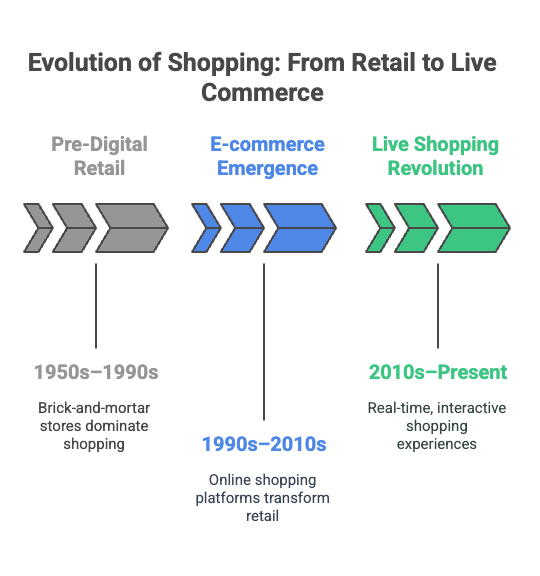
In China, live shopping rakes in over 200 billion dollars each year. India is quickly catching up, boasting 15 billion dollars in live commerce sales. Meanwhile, the United States is still on the rise, with sales in the low hundreds of millions, but the potential here is enormous.
The statistics tell a fascinating tale. While 74 percent of Chinese shoppers have made a purchase through live streams, only 22 percent of American shoppers have given it a shot. In India, 45 percent of online shoppers have tuned into live shopping events in the past year.
This disparity highlights one of the biggest opportunities in today’s commerce landscape. As platforms like Amazon, TikTok, Instagram, and YouTube pour billions into live shopping features, the competition is heating up to seize this expanding market across three major economies.
Understanding Live Shopping
Live shopping is like having your very own shopping buddy right on your phone or computer. The host shows you how products work, answers your questions on the spot, and helps you make quick buying decisions.
Unlike the usual online shopping experience where you sift through reviews and stare at photos, live shopping lets you see products in action. You can ask the host to show different angles, explain features, or even demonstrate the product live while you watch.
This format really builds trust between shoppers and sellers. When you see someone using a product in real-time and responding to your specific questions, it feels way more genuine than just reading anonymous reviews or looking at polished photos that might not tell the whole story.
Most live shopping events run anywhere from 30 minutes to two hours. During that time, hosts might showcase anywhere from 10 to 50 different products, depending on the setup. Plus, viewers can chat with each other and the host, creating a fun community vibe around shopping.
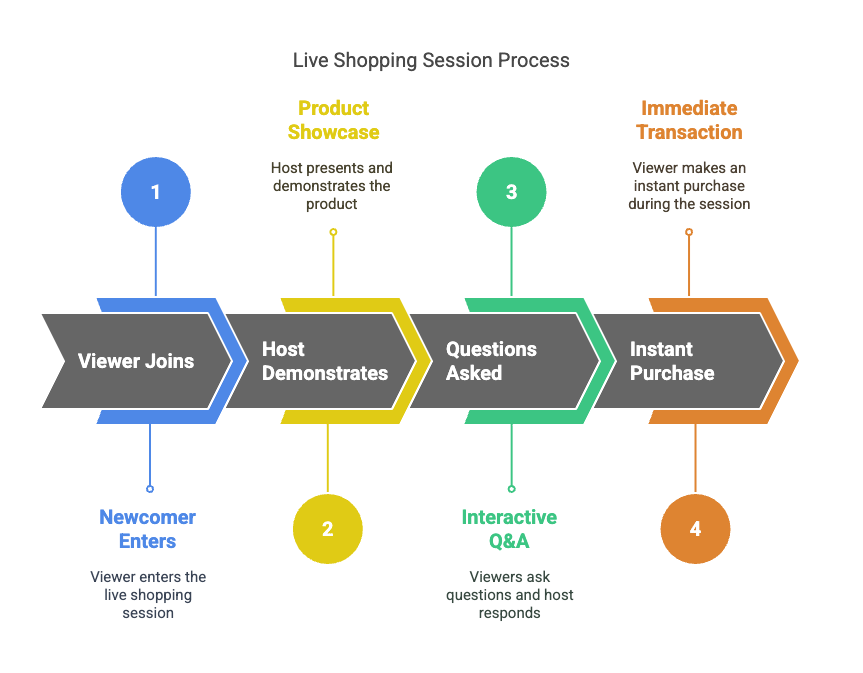
The instant purchase feature is what really makes live shopping stand out. Instead of just adding items to a cart and thinking it over later, viewers can buy right away while the excitement is high. This often leads to better conversion rates compared to traditional online shopping.
Payment options can vary by platform, but the best live shopping experiences keep everything streamlined. Viewers can complete their purchases without ever leaving the video stream, which helps reduce the chances of second-guessing their decisions.
China: The Global Leader in Live Shopping
China didn’t just jump on the live shopping bandwagon; it actually created the modern version of it. The country has turned live streaming from a form of entertainment into a powerful commercial force, raking in more revenue than entire industries in other parts of the world.
This journey kicked off around 2016 when platforms like Taobao Live started to dabble in live commerce. By 2020, it had taken off, with millions of Chinese consumers weaving live shopping into their everyday lives.
Leading the charge is Alibaba’s Taobao Live, boasting over 100 million active users each month. During the 2020 Singles Day shopping extravaganza, the platform pulled in a staggering 7.5 billion dollars in sales within just the first half-hour!
What’s behind this success in China? It’s all about the seamless blend of social media, payment systems, and logistics. When someone makes a purchase during a live stream on platforms like Douyin or Kuaishou, they never have to leave the app. Everything flows effortlessly in one spot.

The hosts of these live shopping events, known as “live streamers,” have become stars in their own right. Big names like Viya and Li Jiaqi can sell millions of dollars’ worth of products in a single session. In fact, Li Jiaqi once sold 15,000 lipsticks in just five minutes during a live stream!
We can’t overlook the cultural aspect either. Chinese consumers love the social side of live shopping, often tuning in with friends or family. It transforms shopping into a fun experience, making it something to share rather than just a solo task.
Chinese platforms are also top-notch when it comes to data analysis. They keep a close eye on viewer behavior, engagement trends, and purchase histories to fine-tune everything from product choices to timing. This data-driven strategy helps hosts pinpoint exactly what their audience is eager to buy.
The success has attracted global attention. International brands now consider China’s live shopping platforms essential for reaching Chinese consumers. Companies like L’Oreal, Nike, and Apple regularly host live shopping events on Chinese platforms to launch new products.
Government support has also helped. Chinese authorities recognize live shopping as a driver of economic growth and have created favorable policies for platforms and creators. This support has helped the industry grow faster than it might have otherwise.
The infrastructure in China supports rapid delivery, often within hours of purchase. This quick fulfillment makes the live shopping experience even more satisfying for consumers, who receive their products while the excitement of the purchase is still fresh.
India: The Emerging Powerhouse
India is poised to become a major player in the live shopping scene, blending the excitement seen in China with its own unique flair. With a huge population and increasing internet access, the stage is set for live commerce to really take off.
In 2023, the Indian live shopping market hit a staggering 15 billion dollars, growing at an impressive 85 percent year-over-year. This surge is fueled by more people getting smartphones, affordable internet data, and a youthful audience that craves interactive experiences.
Platforms like Instagram and Facebook are at the forefront of live shopping in India, boasting over 200 million users engaging with shopping content each month. Local players such as Meesho and ShareChat are also stepping up, adding live shopping features to compete with their international counterparts for the attention of Indian shoppers.
When it comes to live shopping in India, fashion, beauty, and home goods take center stage. Fashion shows and beauty tutorials are particularly popular, with creators highlighting budget-friendly products that resonate with price-sensitive consumers. The most successful live shopping events often feature items priced under 2,000 rupees.
India’s rich tapestry of languages presents both opportunities and challenges. Successful live shopping hosts frequently switch between Hindi, English, and various regional languages during their streams, allowing them to connect with a wider audience. This multilingual strategy fosters trust among viewers from different backgrounds.
Small businesses and individual entrepreneurs are jumping on the live shopping bandwagon to connect directly with customers. Many sellers who once relied on traditional brick-and-mortar stores are now using live streaming to showcase their products to a nationwide audience without the need for costly marketing efforts.
When it comes to payments, India’s approach caters to local preferences. Platforms accommodate UPI payments, digital wallets like Paytm and PhonePe, and cash-on-delivery options. This variety helps ease the concerns some Indian consumers have about online transactions.
The festival season drives massive live shopping activity in India. During Diwali, Dussehra, and other major festivals, live shopping sales can increase by 300 percent as families shop for gifts, clothes, and home decorations through live streams.
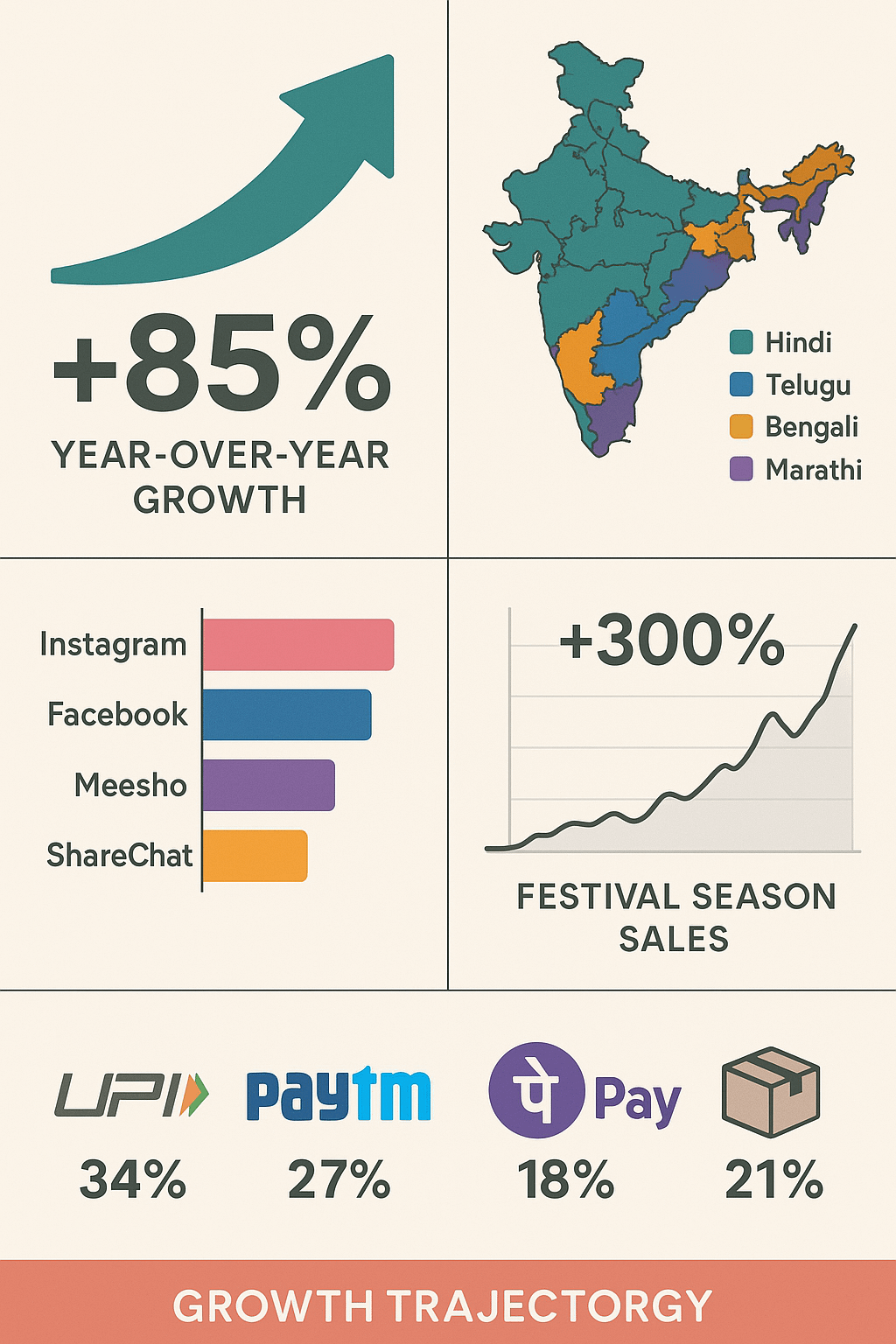
Rural India represents a huge untapped market for live shopping. As internet connectivity improves in smaller towns and villages, platforms are creating content specifically for rural audiences. This includes local language streams and products relevant to rural lifestyles.
Indian creators have developed a unique style that blends entertainment with practical product demonstrations. Many successful live shopping hosts act more like friends giving advice rather than traditional salespeople, which resonates well with Indian cultural values of personal relationships.
The growth potential in India is enormous. With only 45 percent of online shoppers having tried live shopping, there is significant room for expansion. Industry experts predict the Indian market could reach 50 billion dollars by 2027 if current growth rates continue.
United States: Catching Up to the Global Trend
The United States is just starting to embrace live shopping, but big players are pouring in resources to tap into what could be a huge market. American shoppers are gradually getting used to this new way of buying as it gains traction. Amazon Live is at the forefront, featuring hosts like Myriam Sandler, known as @mothercould, who showcases products to thousands of viewers. In 2022, Amazon reported a 40 percent increase in live shopping engagement year-over-year, indicating that American consumers are showing more interest.
However, there’s a hurdle to overcome: changing shopping habits. Americans typically like to do their homework before making a purchase, often comparing prices on various websites. Live shopping, on the other hand, encourages more spontaneous buying, which is a shift from the usual American shopping mindset.
TikTok Shop could be the biggest disruptor in the U.S. market. The platform is experimenting with features that enable direct purchases within the app, much like successful platforms in China. Early feedback is encouraging, with 60 percent of TikTok users finding new products through the app.
YouTube is also getting in on the action by teaming up with Shopify to introduce live shopping features in creator videos. Initial tests revealed a 20 percent boost in conversion rates when creators utilized live shopping tools compared to standard product placements. This suggests there’s significant room for growth.
Traditional shopping networks like QVC and HSN are evolving to keep up with social media platforms. After their merger in 2017 for $2.1 billion, they’ve been focusing on digital transformation and saw a 100 percent increase in social media followers during the pandemic.
The creator economy in the U.S. is laying a solid groundwork for the growth of live shopping. Influencers like Tiana Young Morris have shifted from conventional careers to become full-time live shopping hosts, earning six times their previous salaries through commissions and sponsored content.
American brands are experimenting with live shopping but often struggle with execution. Many events feel too much like traditional advertisements rather than authentic demonstrations. Successful American live shopping requires creators who can build genuine relationships with their audiences over time.
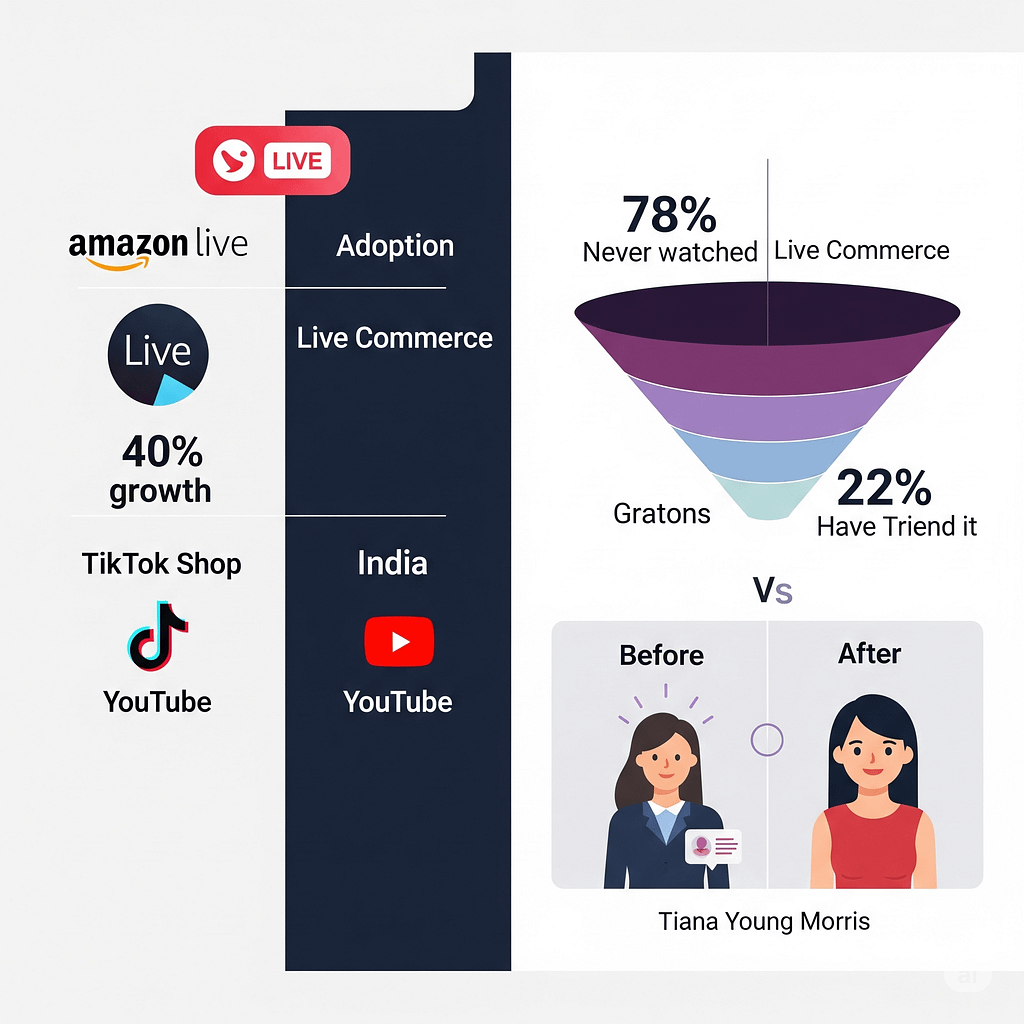
The technical infrastructure in America supports live shopping growth. Fast internet, reliable payment systems, and efficient logistics networks provide the foundation needed for successful live commerce. However, platforms still need to improve integration between streaming and purchasing systems.
Consumer education remains a major challenge. Since 78 percent of American shoppers have never watched a live shopping event, platforms must invest in marketing and education to help consumers understand the benefits of live shopping over traditional online purchasing methods.
The Psychology Behind Live Shopping Success
Live shopping thrives because it taps into some core aspects of human psychology, like trust, social connection, and that sweet feeling of instant gratification. By understanding these psychological triggers, we can see why this format resonates so well across various cultures and markets.
Trust is the cornerstone of live shopping’s success. When consumers watch a real person demonstrate a product and respond to questions with honesty, it feels way more reliable than sifting through anonymous reviews or glossy product photos that might not tell the whole story.
The social element adds a sense of community to the shopping experience. Viewers engage in conversations with each other and the host, sharing their thoughts and experiences. This interaction transforms shopping from a lonely task into a collective experience, easing the anxiety that often comes with online purchases.
Instant gratification is a major motivator behind many live shopping buys. The thrill of seeing a product showcased live and having the option to purchase it right away creates an excitement that often leads to impulse buys. This approach works particularly well for items that are straightforward and not too pricey.
Then there’s the fear of missing out, or FOMO, which is a powerful psychological force. Live shopping events frequently highlight limited-time deals or exclusive products that are only available during the stream. This sense of scarcity pushes viewers to act fast instead of putting it off for later.
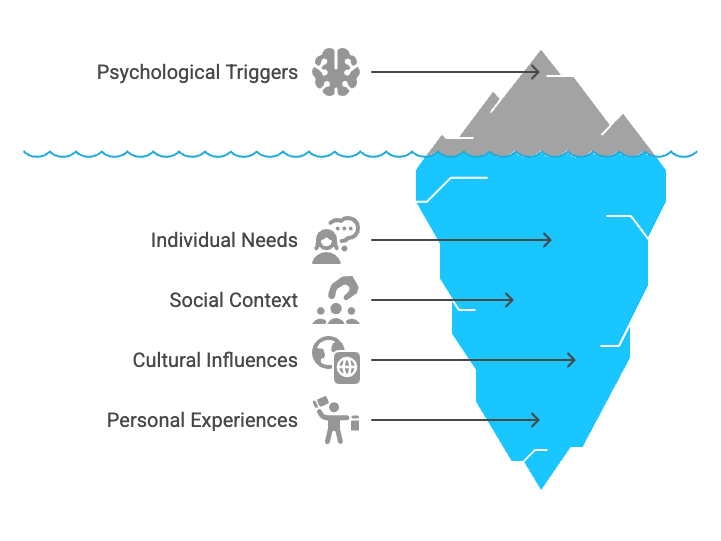
We can’t overlook the entertainment factor, either. Great live shopping hosts are like performers, keeping viewers hooked with their charisma, humor, and storytelling. This makes the shopping experience fun rather than a tedious chore.
Authenticity really strikes a chord with younger consumers, who are often skeptical of traditional advertising. When creators showcase both the ups and downs of products or admit when something doesn’t quite hit the mark, it builds trust that can lead to sales.
The personal connection between creators and viewers develops over time through regular live streams. Viewers begin to trust creators' judgment and recommendations, leading to higher conversion rates and repeat purchases. This relationship-building is crucial for long-term success in live shopping.
Technology and Infrastructure Requirements
Successful live shopping hinges on having a solid tech infrastructure that can support real-time video streaming, quick payments, and a smooth user experience. The technical needs can differ quite a bit across various markets and platforms.
When it comes to video streaming, quality is key for a successful live shopping experience. If the video is grainy, the audio is off, or there’s constant buffering, it can really put a damper on the shopping vibe and drive viewers away. That’s why platforms need to invest in content delivery networks and streaming tech to ensure everything runs smoothly around the world.
Payment integration plays a huge role in conversion rates during live shopping. The top platforms let customers make purchases without ever leaving the video stream, using one-click payment options or saved payment details. Any hiccup in the payment process can significantly lower the chances of viewers completing their purchases.
Real-time chat and interaction features are vital for fostering a sense of community and trust. Viewers should be able to ask questions and get quick answers from hosts or fellow community members. This calls for strong chat systems that can manage thousands of users at once.
Mobile optimization is essential since most live shopping takes place on smartphones. Platforms need to make sure that video quality, chat features, and payment systems work seamlessly on mobile devices, regardless of screen size or internet speed.
Inventory management can get tricky in live shopping, especially when popular items can sell out in a flash. Platforms need real-time inventory tracking and automatic updates to avoid overselling and disappointing customers who think they’ve snagged a product.
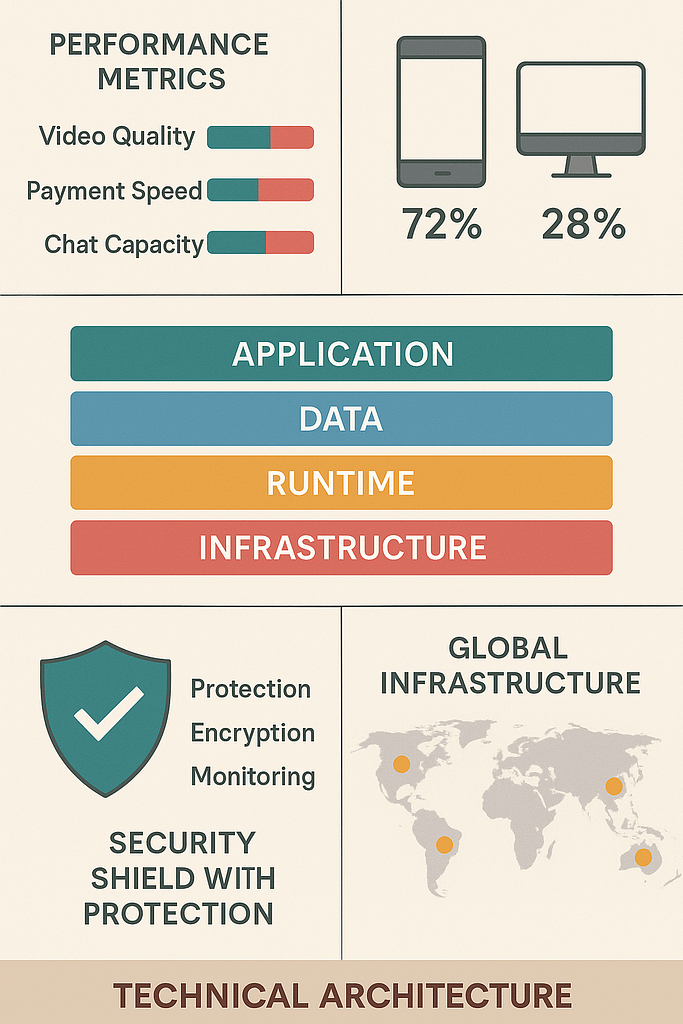
Data analytics are invaluable for platforms and creators looking to enhance their live shopping events. By understanding viewer behavior, engagement trends, and purchase data, they can refine their product selection, timing, and presentation strategies to boost sales and keep viewers happy.
Security is paramount when handling real-time payments and personal information. Live shopping platforms must implement strong security measures to protect both buyers and sellers from fraud while maintaining the speed and convenience that makes live shopping appealing.
The Role of Creators and Influencers
Creators and influencers are truly the lifeblood of thriving live shopping ecosystems. Their knack for building trust, entertaining audiences, and driving sales is what ultimately decides the fate of live shopping platforms across various markets worldwide.
The most successful live shopping creators blend their entertainment skills with a solid understanding of products and sales techniques. They have to keep viewers engaged for hours, all while sharing valuable insights about the products and maintaining an energy level that keeps audiences hooked and ready to buy.
Establishing genuine connections with audiences is a journey that requires time and consistent effort. The top live shopping creators stream regularly, interact with viewer comments and questions, and share personal stories that help viewers see them as relatable individuals rather than just salespeople.
What sets great creators apart from the good ones is their product selection skills. They know which products will resonate with their specific audience, when to introduce them, and how to balance popular items with fresh finds. This expertise comes from experience and a deep understanding of the market that develops over time.
Storytelling is another vital skill that helps creators link products to the needs and desires of their viewers. Instead of merely listing product features, successful creators weave narratives about how these products fit into viewers’ lives, solve their problems, or help them reach their goals.
As live shopping evolves, technical skills are becoming increasingly important. Creators need to grasp lighting, camera angles, audio quality, and streaming software to create professional-grade content that stands up against traditional media and other creators.
Finally, business savvy is what will determine a creator’s long-term success in the live shopping arena. Understanding commission structures, negotiating with brands, managing taxes, and building sustainable businesses around live shopping requires entrepreneurial skills that go beyond just creating content.
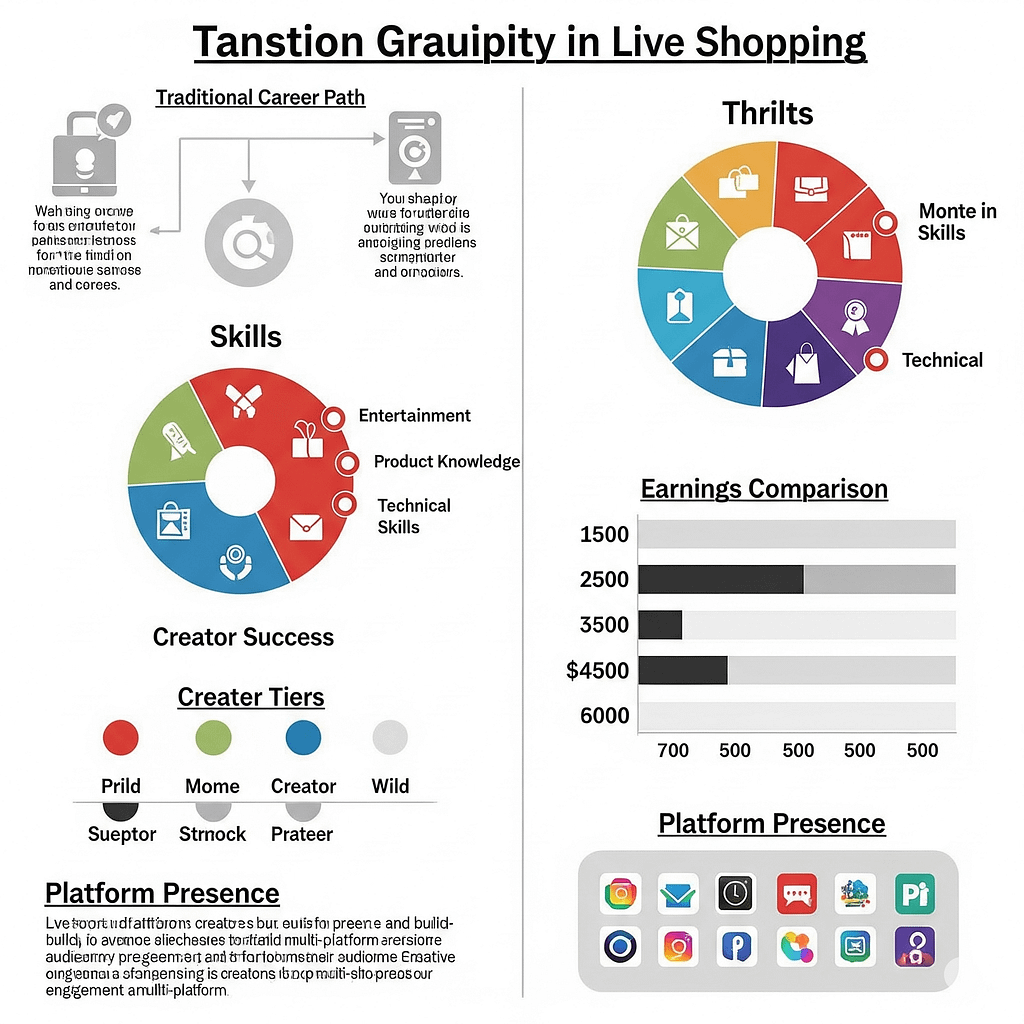
Cross-platform presence helps creators build larger audiences and reduce dependence on single platforms. Many successful live shopping creators maintain presences on multiple platforms, adapting their content and style to work effectively on each platform while maintaining their core brand identity.
Cultural Differences and Adaptation
To achieve success in live shopping, it’s crucial to grasp and adapt to the cultural nuances that shape shopping habits, communication styles, and social norms. What resonates in one country might not seamlessly fit into another market without some thoughtful adjustments.
In China, the live shopping scene thrives on group buying and the need for social validation. Many consumers enjoy the experience of shopping together online, chatting about their purchases with friends and family during live streams. This social element is woven into the platform features and the way creators present their products.
On the other hand, Indian live shopping tends to highlight value and practicality. Indian shoppers are generally mindful of their budgets and want to see how products can genuinely enhance their lives. Successful creators in India dedicate a lot of time to explaining the benefits and comparing different options.
Meanwhile, American live shopping is still finding its footing, but early trends indicate that consumers here appreciate a blend of educational content and entertainment. They want to thoroughly understand products before making a purchase, even in live shopping scenarios that typically encourage impulse buys.
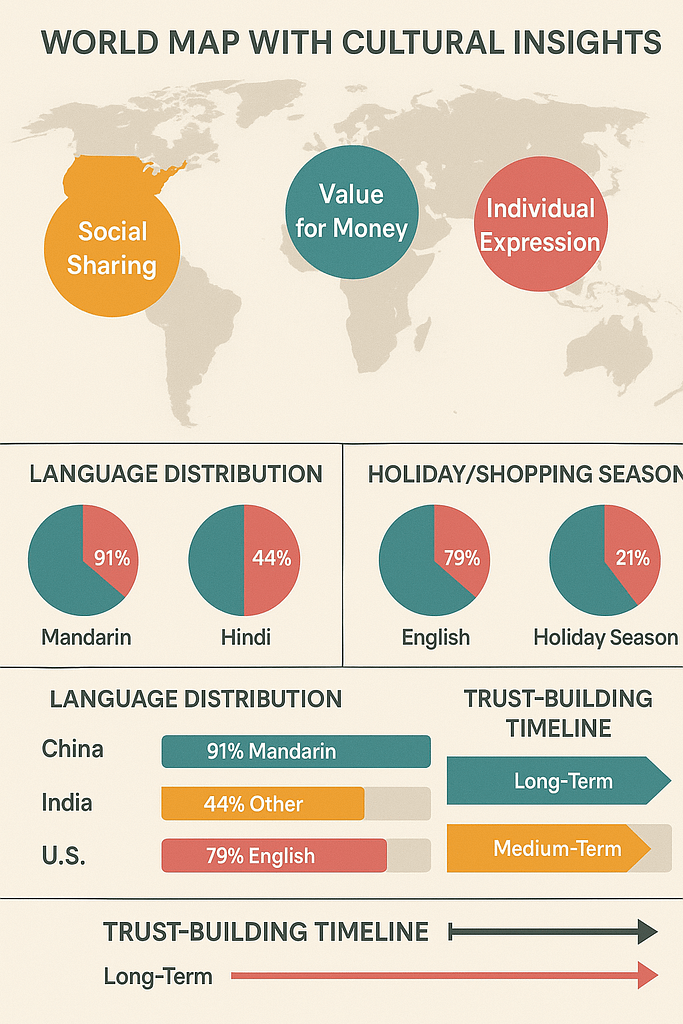
Language plays a significant role and varies widely across different markets. While English is widely understood, content in local languages often performs better. In India, for instance, successful creators frequently blend Hindi, English, and regional dialects. In China, Mandarin is the primary language, but regional dialects can also resonate with specific audiences.
Cultural holidays and shopping seasons influence behaviors in each market. Events like China's Singles Day, India's festive seasons, and America's Black Friday each present unique opportunities for live shopping, necessitating tailored strategies and product choices.
Building trust also varies by culture. Chinese consumers may have a higher level of trust in platforms and systems, while Indian and American shoppers often prefer to establish a more personal connection with creators before making purchases, especially if they haven’t followed them for long.
Product categories that succeed in live shopping vary by culture. Beauty and fashion work well globally, but specific products within these categories may appeal to different markets. Understanding local preferences is crucial for creator and platform success.
Challenges and Obstacles
Live shopping is on the rise and has a ton of potential, but it’s not without its hurdles. These challenges can differ from one market to another, and if platforms, creators, and brands don’t tackle them head-on, they could really hold back future growth.
One major issue is technology. In many areas, people still struggle with reliable internet, modern smartphones, and digital payment options. These gaps in infrastructure mean that a lot of potential customers can’t even join in on the live shopping experience.
Then there’s the need for consumer education, especially in places where live shopping is still a fresh concept. Many folks don’t quite get how it works, have concerns about security, or simply stick to their usual shopping habits. Changing these mindsets will take ongoing marketing and educational efforts.
Another challenge is platform fragmentation, which can leave both creators and consumers feeling a bit lost. With so many platforms offering live shopping features, audiences can get spread too thin, and creators have to choose where to put their energy. This fragmentation can really stifle the growth of individual platforms.
Payment integration is another tricky area, especially when platforms send users off to other sites to finish their purchases. Each extra step in the buying process can really hurt conversion rates, so having a smooth payment experience is key to success.
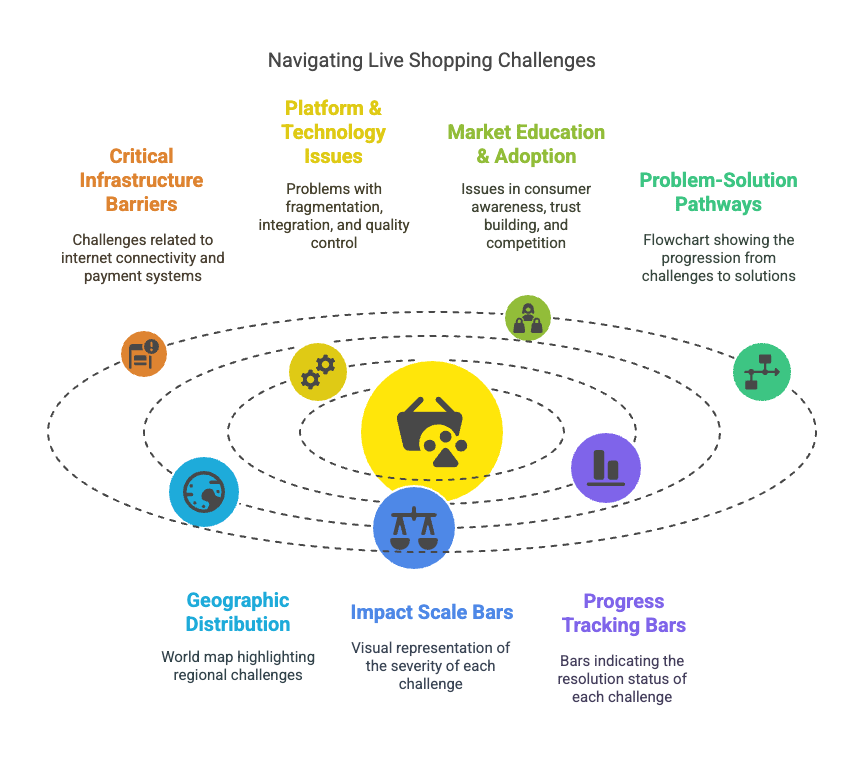
Quality control also becomes a tough nut to crack when platforms are hosting thousands of live shopping events at once. It takes a lot of investment in monitoring and support systems to ensure that creators are giving accurate product info, being honest about what they’re selling, and providing good customer service.
Lastly, logistics and fulfillment can get complicated with live shopping. Popular products can fly off the shelves, and customers expect speedy delivery. Keeping track of inventory across various creators and live events demands some pretty sophisticated systems and partnerships.
Future Opportunities and Predictions
The future of live shopping looks incredibly promising across all major markets, with a variety of trends and opportunities that could fuel ongoing growth and expansion into new product categories and consumer segments. The integration of artificial intelligence is set to elevate live shopping experiences by providing smarter product recommendations, automated chat responses, and real-time translation services, making it easier for creators to connect with global audiences more effectively than the current manual methods allow.
Virtual and augmented reality technologies have the potential to revolutionize live shopping by enabling customers to virtually try on products or see how items would look in their own homes. As VR and AR technology becomes more accessible, these features could soon become standard offerings on live shopping platforms.
There are also exciting global expansion opportunities for successful platforms and creators. Chinese platforms are already making strides internationally, while American and Indian platforms are on the lookout for new markets. Cross-border live shopping could emerge as a major growth driver for international commerce.
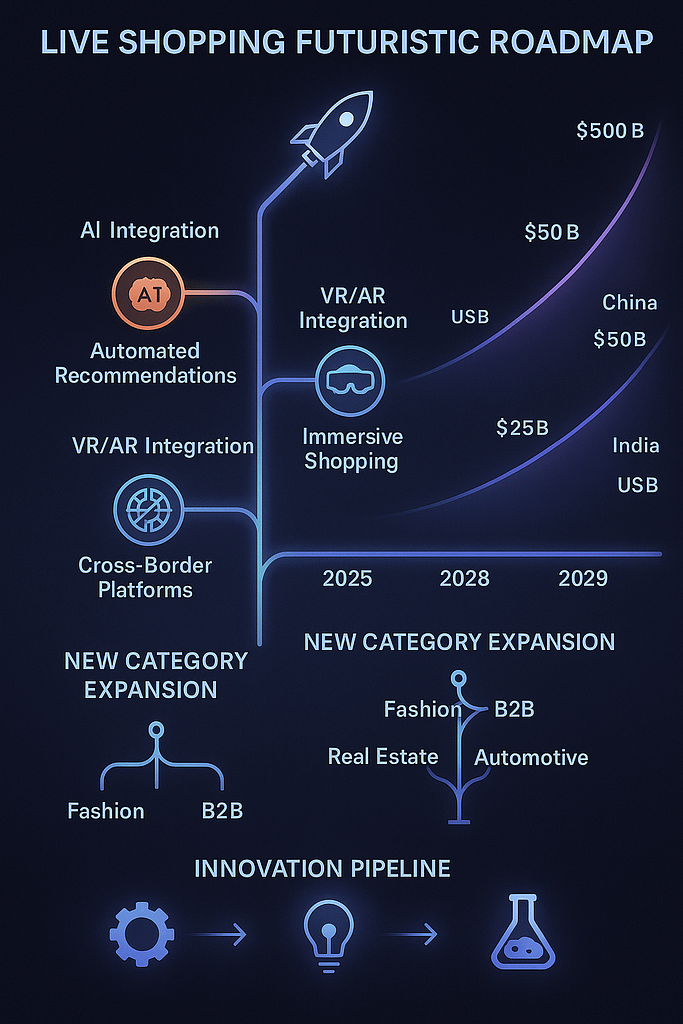
New product categories are continually making their way into live shopping. While fashion and beauty currently lead the charge, sectors like home improvement, automotive accessories, and even real estate are starting to explore live shopping formats tailored to their unique needs.
Business-to-business live shopping is another untapped market with huge potential. Professional buyers could greatly benefit from live product demonstrations, expert insights, and real-time Q&A sessions when making purchasing decisions for their companies.
Finally, integrating live shopping with traditional retail could create a seamless shopping experience that bridges the gap between online and offline. Imagine live shopping events hosted from physical stores or options that allow for immediate in-store pickup—combining the best of both worlds!
Educational content integration will likely become more important as consumers seek value beyond just product sales. Live shopping events that teach skills, provide entertainment, or offer exclusive content alongside product sales could build stronger audience loyalty and engagement.
Economic Impact and Market Size
The economic impact of live shopping goes well beyond just the numbers on sales reports. It’s creating new job opportunities, giving a boost to small businesses, and sparking significant economic activity across various industries and markets.
When it comes to job creation, live shopping isn’t just about the creators and hosts you see on screen. It also includes a whole range of roles like technical support staff, content producers, logistics coordinators, and platform developers. This industry has already generated hundreds of thousands of jobs worldwide, and as markets keep growing, even more positions are on the horizon.
One of the standout benefits of live shopping is how it supports small businesses. Individual entrepreneurs and smaller companies can connect with large audiences without needing to spend a fortune on marketing or maintain physical storefronts. This leveling of the playing field for sales channels is a real boost for economic growth and innovation.
We’re also seeing a notable increase in tax revenue from live shopping in major markets. Governments are crafting new tax policies and regulations to tap into the revenue from this booming industry while also fostering ongoing growth and innovation.
Investment in live shopping platforms and technology is on the rise. Venture capital firms and big corporations are pouring billions into live shopping tech, creators, and platform development, which shows a strong confidence in the future of this industry.
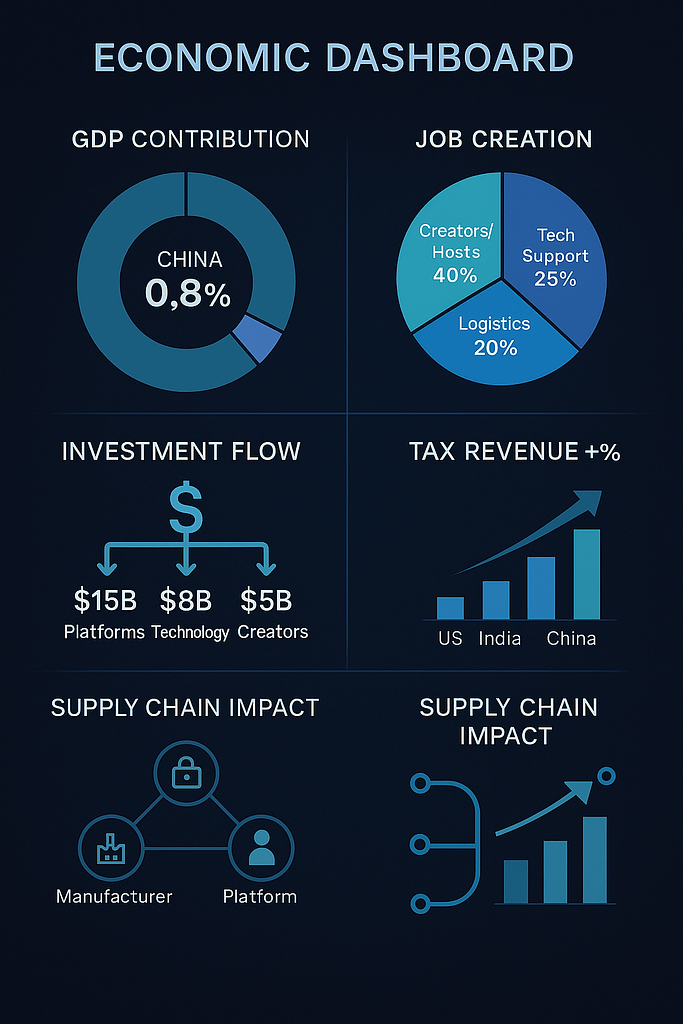
The effects on supply chains are significant too, as live shopping is transforming how products get from manufacturers to consumers. With quicker inventory turnover, direct-to-consumer shipping, and real-time demand signals, supply chains are becoming more efficient and waste is being reduced.
Lastly, we’re starting to see the impact on currency and international trade as live shopping opens up more avenues for cross-border commerce. Consumers can now buy directly from creators and businesses in other countries, which is ramping up international trade and currency exchange activity.
Economic measurement challenges arise as traditional retail metrics may not fully capture live shopping's impact. New measurement methods are needed to understand the full economic effects of this rapidly growing industry on local and global economies.
The Future of Interactive Commerce
Live shopping is more than just a trendy way to shop online; it marks a significant shift towards a more interactive, social, and entertaining shopping experience. This evolution could completely change how consumers find, assess, and buy products around the world.
The success seen in China highlights the enormous potential of live shopping once it becomes mainstream. With annual sales surpassing 200 billion dollars, China has shown that live shopping can emerge as a major player in retail, rather than just a passing fad.
India’s rapid growth further illustrates that live shopping can thrive in various economic climates and cultural contexts. The market, valued at 15 billion dollars and growing at an impressive 85 percent each year, suggests that the appeal of live shopping goes beyond China’s specific market dynamics and resonates with other significant emerging economies.
In the United States, although the market is still in its early stages, it holds the greatest potential for live shopping platforms and creators. If adoption rates in America mirror those in China and India, the U.S. could become the largest live shopping market in the world within the next decade.
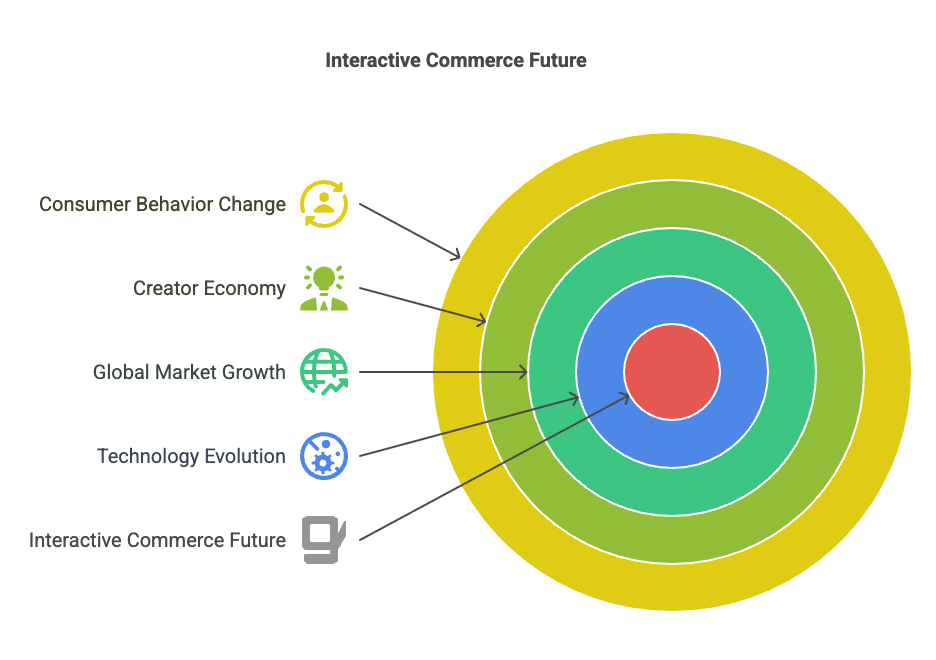
Advancements in technology will keep enhancing live shopping experiences, making them more engaging, accessible, and effective for both buyers and sellers. As global internet infrastructure improves and technologies like AR and VR become commonplace, live shopping is likely to become even more enticing.
The creator economy lays a solid groundwork for ongoing growth in live shopping. As more individuals get comfortable with creating content and building online audiences, the pool of potential live shopping hosts is expanding, bringing in greater diversity and specialization to the field.
Competition among platforms will spur innovation and elevate live shopping experiences. As major tech companies vie for market share, consumers will reap the rewards with improved features, lower prices, and a wider array of options for engaging with live shopping content.
The blending of entertainment and commerce that live shopping offers is set to redefine the retail landscape.







